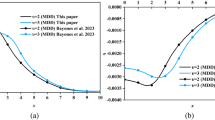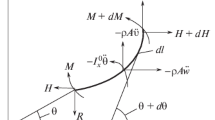Abstract
This work models, analyses and simulates a coupled dynamic system consisting of a thermoviscoelastic rod and a linear viscoelastic beam. It is motivated by recent developments in MEMS systems, in particular the “V-shape” electro-thermal actuator that realizes large displacement and reliable contact in MEMS switches. The model consists of a system of three coupled partial differential equations for the beam’s and the rods’ displacements, and the rod’s temperature. Moreover, the rod may come in contact with a reactive foundation at one end, which is the main aspect of the actuating or switching property of the system. The thermal interaction at the contacting end of the rod is described by Barber’s heat exchange condition. The system is analyzed by setting it in an abstract form for which the existence of a weak solution is shown by using tools from the theory of variational inequalities and a fixed point theorem. A numerical algorithm for the system is constructed; its implementation yields computational depiction of the system’s behavior, with emphasis on the combined vibrations of the beam-rod system, dynamic contact force and thermal interaction.













Similar content being viewed by others
References
Ahn, J., Kuttler, K.L., Shillor, M.: Dynamic contact of two Gao beams. Electron. J. Diff. Eqn. 2012(194), 1–42 (2012)
Andrews, K.T., Shi, P., Shillor, M., Wright, S.: Thermoelastic contact with Barber’s heat exchange condition. Appl. Math. Optim. 28(1), 11–48 (1993)
Andrews, K.T., Shillor, M.: Thermomechanical behaviour of a damageable beam in contact with two stops. Applicable Anal. 85(6–7), 845–865 (2006)
Andrews, K.T., Kuttler, K. L., Shillor, M.: Dynamic Gao beam in contact with a reactive or rigid foundation. Chapter in Weimin Han, Stanislaw Migorski, and Mircea Sofonea (Eds), advances in variational and hemivariational inequalities with applications, advances in mechanics and mathematics (AMMA) 33, 225–248 (2015)
Barber, J.R.: Stability of thermoelastic contact. Proc. IMech. Intl. Conference on Tribology, London, 981–986 (1987)
Bien, M.: Existence of global weak solutions for coupled thermoelasticity with Barber’s heat exchange condition. J. Applied Anal. 9(2), 163–185 (2003)
Dumont, Y., Paoli, L.: Numerical simulation of a model of vibrations with joint clearance. Int. J. Computer Applications in Technol. 33(1), 45–53 (2008)
Han, W., Sofonea, M.: Quasistatic contact problems in viscoelasticity and viscoplasticity, studies in advanced mathematics 30. AMS-IP, Rhode Island (2002)
Khazaai, J.J., Qu, H., Shillor, M., Smith, L.: An electro-thermal MEMS Gripper with large tip opening and holding force: design and characterization. Sens. Transducers J. 13, Special Issue, 31–43 (2011)
Kikuchi, N., Oden, J.T.: Contact problems in elasticity: a study of variational inequalities and finite element methods. SIAM, Philadelphia (1988)
Klarbring, A., Mikelic, A., Shillor, M.: Frictional contact problems with normal compliance. Int. J. Engng. Sci. 26(8), 811–832 (1988)
Kuttler, K.L., Shillor, M.: Dynamic contact with normal compliance wear and discontinuous friction coefficient. SIAM J. Math. Anal. 34(1), 1–27 (2002)
Kuttler, K.L., Li, J., Shillor, M.: Existence for dynamic contact of a stochastic viscoelastic Gao Beam. Nonlinear Anal. RWA 22(4), 568–580 (2015)
Kuttler, K.L., Li, J., Shillor, M.: Stochastic differential inclusions. submitted
Martins, J.A.C., Oden, J.T.: A numerical analysis of a class of problems in elastodynamics with friction. Comput. Meth. Appl. Mech. Engnr. 40, 327–360 (1983)
Paoli, L.: An existence result for non-smooth vibro-impact problems 211(2), 247–281 (2005)
Shillor, M., Sofonea, M., Telega, J.J.: Models and analysis of quasistatic contact, lecture notes in physics, 655. Springer, Berlin (2004)
Steen, M., Barber, G.C., Shillor, M.: The heat exchange coefficient function in thermoelastic contact. Lubrication Eng. 3, 10–16 (2003)
Strikwerda, J.: Finite difference schemes and partial differential equations. Wadsworth, New York (1989)
Xu, X.: The N-dimensional quasistatic problem of thermoelastic contact with Barber’s heat exchange condition. Adv. Math. Sci. Appl. 6(2), 559–587 (1996)
Zeidler, E.: Nonlinear functional analysis and its applications II/B. Springer, New York (1990)
Acknowledgments
We would like to thank the referees for the very careful and thorough review of the paper, which improved the presentation and made it more readable.
Author information
Authors and Affiliations
Corresponding author
A Appendix: Dimensionless System
A Appendix: Dimensionless System
We describe the dimensional and dimensionless forms of the system. The full system, where the dimensional variables are with tildes, is as follows. The dynamic equation for the vibrations of the beam is
the equation for the vibrations of the rod is
and the heat conduction equation for the rod is
Here, \(\widetilde{\theta }(\widetilde{t})\) is the absolute temperature of the rod and \(\theta _{amb}\) is the ambient temperature, assumed to be constant; \( \rho _{b}, \rho _{d}, k_{b}, k_{d}, \widetilde{\nu }_{b}\), and \(\widetilde{\nu } _{d}\), are the densities (per unit length), the elastic coefficients, and the viscosity coefficients of the beam and rod, respectively. The rod’s thermal capacity is \(\widetilde{c}_{th}\), the coefficient of heat conduction is \(\widetilde{\kappa }_{th}\), and \(\widetilde{\alpha }=\alpha ^* (3\lambda +2\mu )\) is its scaled coefficient of thermal expansion. Here, \(\alpha ^*\) is the actual coefficient of thermal expansion and \(\lambda \) and \(\mu \) are the Lame coefficients of the rod. Also, \(\widetilde{h}_{d}\) is the coefficient of heat exchange between the rod and the environment. Moreover, \(\widetilde{f}_{b}\) and \(\widetilde{f}_{d}\) are the (volume) forces acting of the beam and the rod (such as gravity), respectively, and \(\widetilde{Q}_{d}\) is a heat source in the rod, such as heat generated by electric current.
We use, in addition to \(x=\widetilde{x}/L_{b}\) and \(y=\widetilde{y}/L_{b}\), the following dimensionless variables:
and scale the temperature as
where \(\widetilde{\theta }_{e}(\widetilde{t)}\) is the absolute temperature applied at the junction \(y=0\). This scaling is such that \(\theta (0,t)=0\) which helps with some of the mathematical manipulations below.
Next, we let
and
Finally, we set
and
where the dot represents the time derivative.
The dimensionless systems that results is
the equation for the vibrations of the rod is
and the heat conduction equation for the rod is
The last part is to set the heat exchange condition in a dimensionless form. The dimensional condition at \(y=l\) is
Hence, if we set \(r(t)=\widetilde{r}(\widetilde{t)}/L_{b}\), we find
and also
we obtain the heat exchange condition at \(y=l\),
We note that the assumptions on the problem data
and
are very reasonable from the point of view of applications. Moreover, they imply that the normal compliance function has at most linear growth. We note that if we assume that \(h_{NC}\) is Lipschitz, the theorem still holds true.
Rights and permissions
About this article
Cite this article
Ahn, J., Kuttler, K.L. & Shillor, M. Modeling, Analysis and Simulations of a Dynamic Thermoviscoelastic Rod-Beam System. Differ Equ Dyn Syst 25, 527–552 (2017). https://doi.org/10.1007/s12591-016-0301-2
Published:
Issue Date:
DOI: https://doi.org/10.1007/s12591-016-0301-2




